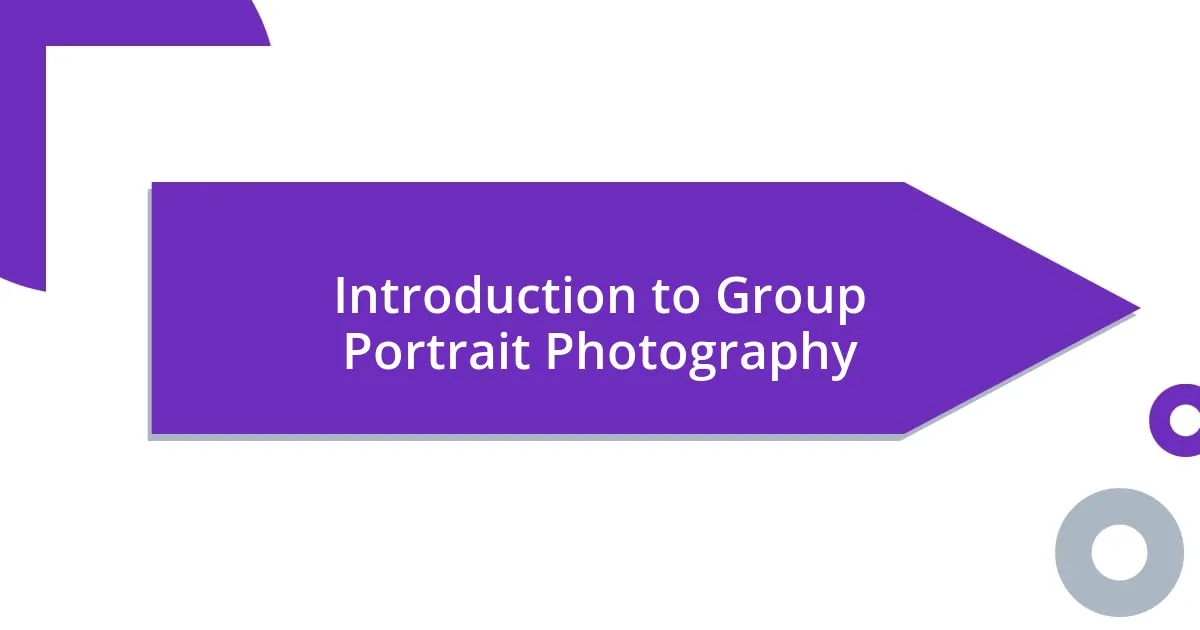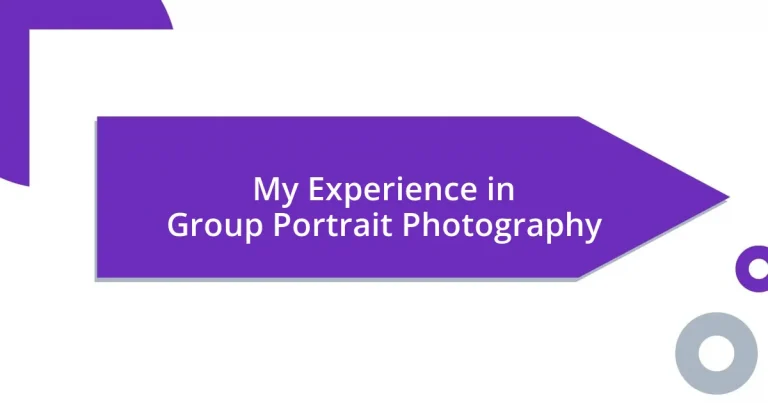Key takeaways:
- Group portrait photography captures relationships and genuine emotions through a relaxed atmosphere and thoughtful engagement.
- Careful planning, including location, timing, wardrobe coordination, and props, significantly influences the quality of group portraits.
- Using effective posing strategies, such as height variation and incorporating props, enhances visual interest and authenticity in the images.
- Post-processing techniques like exposure adjustment, color correction, and selective sharpening can elevate the final image, highlighting the subjects’ expressions.

Introduction to Group Portrait Photography
Group portrait photography captures more than just faces; it encapsulates relationships, shared experiences, and collective memories. I remember attending a family reunion where I was entrusted with the task of snapping a group photo. The excitement of relatives gathering after years apart filled the air, and it made me realize how important these moments are to our personal histories.
When thinking about group portraits, have you ever considered how the dynamics within a group influence the final image? I’ve noticed that a relaxed atmosphere might elicit genuine smiles and laughter. During one shoot, I started with a simple icebreaker, which immediately eased the tension as everyone began interacting with each other, allowing me to capture authentic interactions rather than staged poses.
Lighting, composition, and the arrangement of people play crucial roles in shaping the mood of the portrait. I once experimented with natural light during a late afternoon shoot, and it brought a warm, golden glow that transformed a simple family portrait into a cherished keepsake. Each choice you make in group portrait photography can significantly alter how viewers connect with the image, creating lasting impressions.

Planning the Group Portrait Session
Planning a group portrait session involves several key factors that can profoundly impact the outcome. From my experience, the first step is to communicate with the group. I love discussing what they envision for their portrait, whether it’s a casual gathering or a formal event. I once worked with a sports team that wanted to showcase their camaraderie, and understanding their dynamics made all the difference in capturing their spirit.
Here are some crucial elements to consider during the planning phase:
- Location: Choose a space that holds significance for the group or has good lighting.
- Timing: Schedule the session at a time that works for everyone, considering natural light and energy levels.
- Wardrobe Coordination: Suggest a color palette or theme to create a cohesive look.
- Posing Arrangements: Think ahead about how to arrange group members to optimize visual appeal and ensure everyone is included.
- Props or Backgrounds: Discuss any items that could enhance the portrait, like sports equipment for a team or family heirlooms for personal portraits.
I’ve found that being attentive to these details not only eases the flow of the session but also builds excitement among everyone involved, turning the shoot into a memorable event. Just last summer, I coordinated a family portrait with multiple generations. By involving each person in the planning, we created a meaningful connection that showed in every shot.

Techniques for Capturing Groups
Capturing a group effectively requires thoughtful engagement with the subjects. I remember a corporate event where the team was a bit shy initially. To break the ice, I introduced some fun poses and encouraged them to interact as if they were in a casual setting, which helped transform stiff smiles into genuine laughter. This approach not only made the shoot enjoyable but also created a more authentic representation of their camaraderie.
Another impactful technique is to control the composition by using layers. When photographing my extended family, I arranged them in a staggered formation, ensuring that everyone had a clear view, while taller individuals stood at the back. This arrangement enhances depth and makes the portrait visually compelling. It’s interesting how such small adjustments can elevate an ordinary photo to something more special.
Finally, I’ve learned that patience is vital during group sessions. Once, while working with a large high school graduating class, it took several attempts to get everyone looking their best. I encouraged them to engage with each other, and after a few tries, I managed to capture a moment where laughter erupted. That seemingly chaotic moment resulted in one of the most beloved photos of the day, proving that sometimes, the best shots come from spontaneity.
| Technique | Description |
|---|---|
| Engagement | Encourage interaction to elicit authentic emotions |
| Layering | Use staggered arrangements for depth and visibility |
| Patience | Allow time for spontaneous moments to develop |

Lighting Considerations for Group Shots
Lighting can truly make or break a group portrait, and my experience has taught me the importance of getting it right. I vividly remember a wedding reception where the sun was setting. The soft, golden hour light enveloped the group perfectly, creating a warm glow. By positioning them strategically to take advantage of this natural light, I captured a stunning image that radiated joy and love. It always amazes me how light can evoke such emotion!
When dealing with larger groups, diffused light sources are my go-to. For instance, I once photographed a family reunion in a beautifully wooded park. I strategically placed the group under a canopy of trees that filtered the harsh sunlight. This way, everyone was illuminated evenly, making each person’s features come through without harsh shadows. If you think about it, who wants to look ghostly or, worse, have someone in the back end up in the dark?
Conversely, I often find that artificial lighting can be a fantastic tool, especially indoors or during low-light conditions. In a recent corporate headshot session, I used softbox lights to create a flattering effect that minimized harsh highlights. I could tell the subjects felt more confident under the soft illumination; their smiles seemed more natural, and they loosened up as we progressed. What a difference the right lighting makes in conveying a group’s energy and spirit!

Posing Strategies for Groups
When it comes to posing groups, I often think about everyone’s comfort level. At a family gathering, I decided to have everyone sit on a picnic blanket, which transformed the shoot into a natural and relaxed atmosphere. This simple shift in positioning not only encouraged interaction but also allowed me to capture genuine moments of joy and connection. Isn’t it amazing how just a change in setting can bring out such authentic emotions?
I also play around with height variations to keep things visually interesting. I remember photographing a group of friends at a festival. Instead of everyone standing in a straight line, I asked some to sit on the grass while others stood behind them. This not only showcased the group’s dynamic but also created a three-dimensional effect in the portrait. It got me thinking—why conform to the traditional straight line when there are so many creative possibilities right before us?
Another technique I find valuable is using props or elements from the environment to enhance the composition. During a graduation shoot, I handed out themed items like caps and diplomas, which led to playful interactions. It’s fascinating to see how a simple prop can spark creativity and laughter. It really highlights a key point: encouraging spontaneity can often lead to memorable and lively photographs. Don’t you agree that those candid moments reflect a story that a posed picture just can’t capture?

Post-Processing Group Portraits
Post-processing group portraits can elevate the final image from good to stunning. I recall working on a large family portrait where some faces were simply overshadowed in the original capture. By skillfully adjusting exposure and contrast in post-processing, I brought those features back to life while maintaining the harmony of the overall image. Isn’t it rewarding to see hidden beauty emerge through a few tweaks?
I’ve also learned that color correction plays a pivotal role in post-processing. After a fun beach shoot, I noticed some subjects had warm skin tones while others appeared overly cool due to reflections from the water. Utilizing software to balance the color tones not only unified the group’s appearance, but it also enhanced the vibrant mood of the setting. Who wouldn’t appreciate how effective color coordination can transform a photo into a cohesive narrative?
Finally, I find that selective sharpening can be a game changer, especially in group portraits where clarity is key. During a recent event, I focused on sharpening the eyes of the subjects while keeping the background slightly blurred. This technique drew attention to their expressions, creating a magical connection with anyone who viewed the photo. Isn’t it incredible how a little fine-tuning in post-processing can evoke such powerful emotions?

Lessons Learned from Group Portraits
When capturing group portraits, one lesson I’ve learned is the importance of communication before the shoot. Just the other day, I was working with a large family, and I took some time to chat with them about their ideas and expectations. This simple step not only put them at ease but also allowed me to incorporate elements that were meaningful to them. Have you ever noticed how open dialogue can change the dynamics of a shoot?
Another takeaway for me is to embrace the unexpected. I remember a group of coworkers who were initially stiff and posed, but when I encouraged them to interact and joke around, the energy shifted dramatically. Suddenly, that stiff portrait blossomed into a lively and genuine moment captured in time. Isn’t it fascinating how a little spontaneity transforms a photo from ordinary to extraordinary?
I’ve also realized that lighting plays a crucial role in the mood of group portraits. During a late afternoon shoot, I found myself battling harsh shadows during the golden hour, and instead of fighting it, I used those shadows creatively to add depth. By enhancing contrast in those areas, I created a dramatic yet inviting atmosphere that truly reflected their personalities. Isn’t it amazing how adjusting your approach to a challenge can lead to something beautiful?














